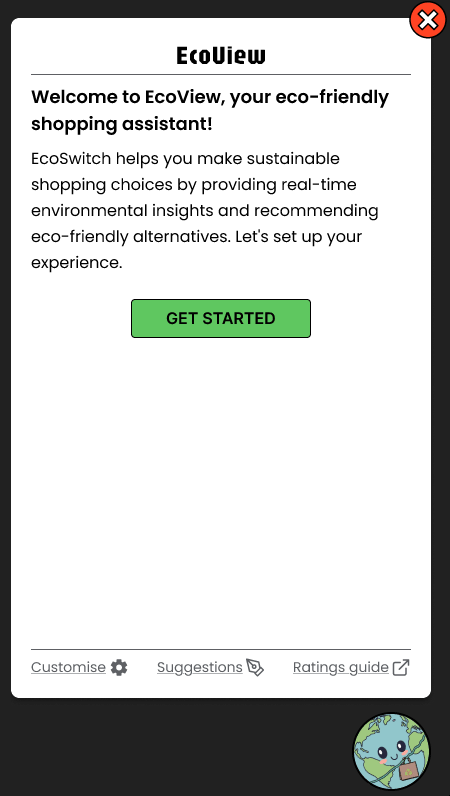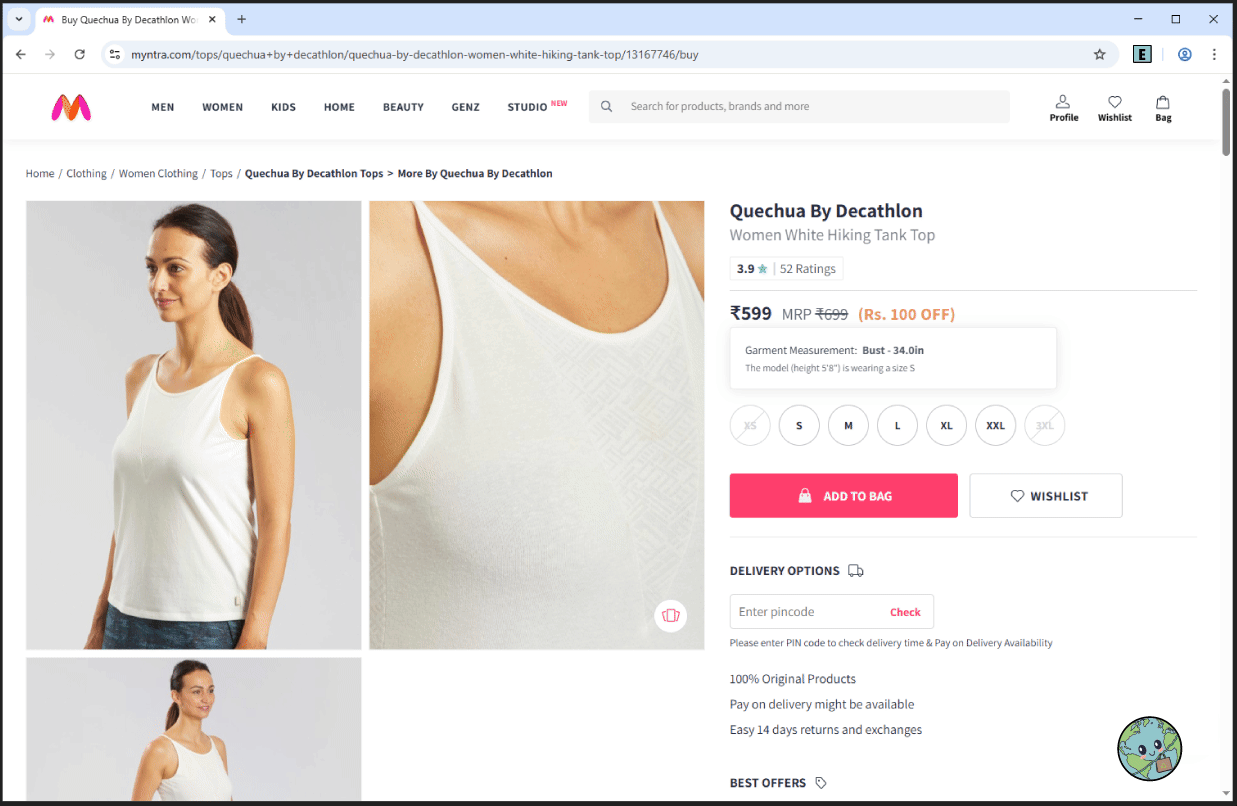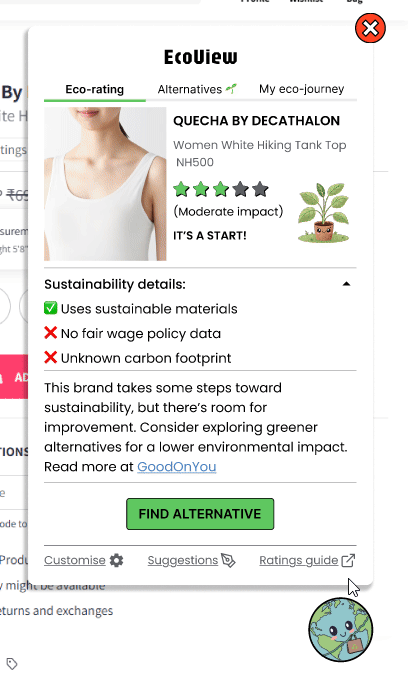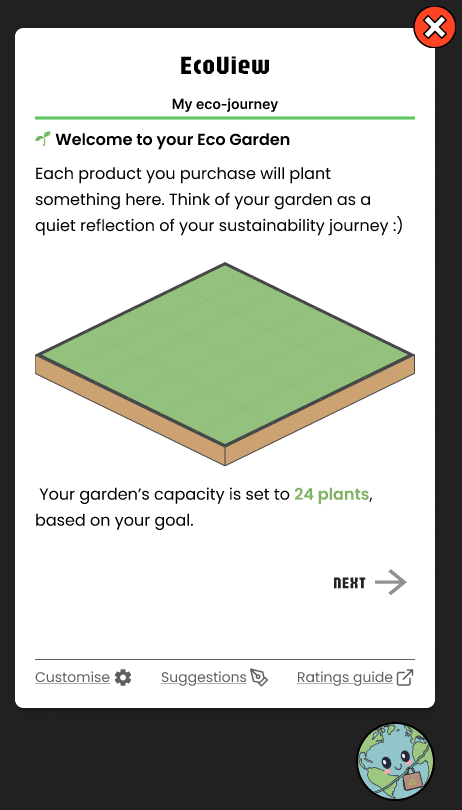
EcoView
A sustainable online shopping assistant
Project synopsis
EcoView is a browser extension designed to help online shoppers make informed, eco-friendly purchasing decisions. By analysing product sustainability data in real time, it provides actionable insights, alternative recommendations, and rewards for greener choices.
Problem
Consumers lack transparency on the environmental impact of their purchases. Existing e-commerce platforms do not provide easy access to sustainability information, making it difficult for users to identify ethical and eco-friendly products.
Analysis
-
Research indicates that while a large percentage of Indian consumers are willing to pay more for sustainable fashion, they are hindered by a lack of clear labeling
-
Generic sustainability claims often lack proof, leading to consumer skepticism
-
Users prioritize convenience, and therefore, sustainability information needs to be seamlessly integrated into their existing shopping experience
Solution
EcoView integrates seamlessly into shopping experiences by:
- displaying sustainability ratings based on fair labor, animal welfare, materials, carbon footprint, and packaging
- suggesting greener alternatives when a product has a high environmental impact
- providing actionable insights to encourage sustainable shopping habits
- gamifying the experience with "consequential" virtual awards and progress tracking
Impact
EcoView is expected to lead to increased user awareness of sustainability ratings during shopping, foster a behavioral shift towards long-term engagement with eco-friendly choices through gamification, and result in more sustainable purchases by making eco-friendly alternatives easier to discover and adopt
01. Uncovering the Gaps
India’s fashion e-commerce market is growing fast, yet consumers often lack clear, actionable sustainability information. While few major platforms like Myntra and Nykaa Fashion have introduced basic sustainability filters, they provide little to no details on how a product qualifies as sustainable. This leaves shoppers without the transparency they need to make informed, eco-friendly choices.
Market Insights & Secondary Research
To ground the problem space, I investigated how users currently interact with sustainable fashion options and what gaps exist:
1. 📊 Consumer Intent vs Action Gap
83% of Indian consumers in a survey by YouGov said they are willing to pay more for sustainable fashion, but lack of clear labeling prevents them from doing so. However, sustainability ranks lower than pricing, design and quality when it comes to shoppers' priorities. (YouGov, 2019)

Source: YouGov.in
2. 🛒 Sustainability Sells When It's Accessible
According to McKinsey's 2022 State of Fashion Technology report, products with sustainability claims showed 1.7x faster growth than those without such claims, proving that demand exists when transparency is improved. (McKinsey)
3. 🔍 While Myntra and Nykaa Fashion, 2 e-comm fashion giants, have introduced sustainability tags, but offers no transparency about criteria, leaving room for improvement (industry research & website analysis)
4. 🌍 Existing tools and market gaps
Third-party sustainability resources create distinct challenges for Indian shoppers: Good On You (ratings platform) requires users to interrupt their shopping journey to research brands elsewhere, reducing follow-through rates. Meanwhile, dedicated marketplaces like DoneGood offer curated sustainable options but are US-focused, leaving a significant gap in the Indian market where no comparable solution exists to help local consumers make informed choices on their preferred shopping platforms.
5. ♻️ Sustainability means fewer, not just better choice
While making sustainable choices matters, reducing overall consumption is equally important. Fashion's environmental footprint is not just about what we buy, but how much. Reducing consumption, re-wearing clothes, and avoiding impulsive purchases are more effective than simply switching brands (UK parliamentary report, 2019)
.png)
.png)
So why does sustainable shopping feel difficult?
🛒 Lack of integrated solutions -- Most platforms do not provide sustainability ratings or eco-friendly alternatives.
📢 Lack of transparency – Even if there is a sustainability option, e-commerce platforms rarely explain what makes a product "sustainable."
⚡ Convenience over sustainability – Shoppers prioritise convenience, price and availability over eco-friendliness
🔍 Confusing information & greenwashing – "Sustainability" means different things to different users, and calling a product "sustainable" without definition or transparency and using vague eco-friendly claims without proof, make it difficult for consumers to trust them.
Simply put, even motivated consumers struggle due to missing or misleading information, disconnected tools, and the natural prioritisation of convenience
02. Challenge
To transform research insights into actionable design opportunities, I framed the key challenges as "How might we" questions, focusing on the most critical points of intervention:
📋 How might we…
💡 provide clear, verifiable sustainability information within the online shopping experience?
💡 encourage sustainable purchases by making eco-friendly options just as accessible as mainstream choices?
💡 build a seamless solution that integrates into existing shopping behaviors instead of requiring extra effort?
03. Meet EcoView
Introducing EcoView -- a browser extension that helps shoppers make informed, sustainable choices by providing real-time sustainability ratings, alternative product recommendations, and a reward-based system -- all within their existing shopping. Key objectives for EcoView were-
Seamless integration – As it is a browser extension, it works across multiple e-commerce platforms. Consumers won’t go out of their way to research sustainability; it needs to be built into their shopping experience.
Actionable insights – Displays sustainability ratings with sources and eco-friendly alternatives. Legible, trustworthy sustainability ratings make decision-making easier.
Habit formation – "Rewards" eco-conscious choices and tracks progress in users' sustainable journey to encourage sustainable behaviours
EcoView aims to directly address these gaps, making sustainability insights transparent, accessible, and actionable for Indian shoppers.
A browser extension is the most viable cross-platform solution, with sustainability data pulled from trusted, third-party sources
04. Designing a Better Decision Flow
To ensure an intuitive and engaging user experience, I explored existing browser extensions that focus on sustainability and shopping assistance. I analysed their UI patterns and interaction flows to identify what works well and what could be improved. This research helped shape EcoView’s interface, ensuring a seamless experience while maintaining clarity in sustainability ratings. The moodboard below showcases some of the key references that influenced the design.

Some existing browser extension designs and features for inspiration for EcoView
Drawing insights from these references, along with the user research findings, I focused on crafting a solution that balances transparency, usability, and engagement. Starting with low-fidelity wireframes, I explored various approaches to displaying sustainability information within the shopping experience. Key design considerations included:

1. Customisability
Let users choose what matters most to them. Whether it’s fair labor practices, animal welfare, or carbon emissions. Sustainability is not one-size-fits-all.

3. Clarity & Transparency
Simplifying complex sustainability data using a visual metaphor system that can be understood at a glance. Instead of overwhelming users with stats, focus is on legibility and quick feedback.

2. Encouraging mindful consumption
Encouraging users to pause and reflect by setting a cap on how many items they intend to purchase in a year, to promote conscious choices and intentionality

4. Visual Progression
Translating individual choices into a broader impact story through a visual dashboard. Each purchase has an impact point, and the user’s collection reflects the sustainability of their wardrobe.
The wireframes helped identify potential usability issues before moving to higher-fidelity designs.
05. A Sneak Peek at EcoView in Action
EcoView’s final design brings together low-friction interactions, meaningful nudges, and a quiet but powerful sense of accountability through a plant-based visual system that makes sustainability information immediately understandable.
Each feature reflects the user’s journey toward more conscious consumption, without demanding perfection.
You can view the prototype here.

1. Choose what matters to you 💚
The onboarding flow allows users to customize sustainability filters based on their personal values and set an annual garment limit, creating both personalization and a gentle accountability mechanism.
2. Real-time Sustainability Ratings 📊
Sustainability information is presented through an intuitive plant metaphor that conveys ratings at a glance, with transparency about data sources and limitations, all without disrupting the familiar shopping experience.

3. Greener alternatives 🔄
Users are presented with visually similar alternatives from better-rated brands, making sustainable choices just as accessible as conventional ones.


4. The Eco-garden 🌱
Each purchase grows an "impact plant" in the user’s virtual garden. Exceeding their self-defined clothing cap causes the garden to reflect overconsumption visually.
06. User Flows
To ensure EcoView provides a seamless experience across different scenarios, I mapped out user flows for the primary interactions with the extension to ensure clarity and ease of use at every step:
1. Initial Setup & Customization flow
The setup flow guides users through preference selection and goal-setting in just three steps, establishing personalisation while introducing the eco-garden concept that will track their progress.
2. Shopping with EcoView
The product analysis flow shows how users seamlessly access sustainability information, understand ratings, and discover alternatives without disrupting their shopping experience across different e-commerce platforms.
3. Purchase Confirmation & Garden Growth
The post-purchase confirmation flow demonstrates how purchases are detected, verified, and added to the eco-garden, reinforcing the connection between shopping choices and environmental impact.
By mapping these flows in detail, I ensured that EcoView would maintain a consistent user experience while accommodating different shopping behaviors and scenarios.
07. Impact



1. Real-time awareness
Providing sustainability information at the point of decision-making helps users develop awareness of brand practices
2. Behavioral shift
Gentle nudges guide more sustainable choices over time, while gamification fosters long-term engagement with eco-friendly choices.
3. Mindful Consumption
The annual purchase goal and garden visualisation encourage users to buy less and choose better.
4. Scalable Impact
Can influence both consumer behavior and brand accountability
08. What Next?
This version of EcoView was intentionally scoped as an MVP, focusing on core functionality that's realistic to build into a browser extension. But it definitely opens up space for much more. Here are some directions I’d be excited to explore further:
📋 Enhanced Data & product-specific ratings
Move beyond brand-level scores and start showing product-level sustainability metrics. The more specific the insights, better the quality of actionable decisions.
🔗 Smoother integrations with e-comm platforms
Instead of working as an overlay, EcoView could plug directly into platforms via an API. That would mean less friction and more seamless nudges while browsing.
🏪 A dedicated conscious shopping space
EcoView could grow into a curated sustainable e-comm marketplace as a one-stop-shop that displays verified eco-friendly products without needing to switch tabs.
09. Final words

EcoView positions sustainability as part of the default shopping experience, and not a separate task. Designing EcoView has also been an exercise in balancing competing objectives:
- Creating an experience that informs without overwhelming - Encouraging mindfulness without inducing guilt
- Building a system that's simple enough for quick decisions yet detailed enough to be meaningful
The most significant insight from this process has been that sustainability tools need to work with human psychology rather than against it. By using visual metaphors, creating gentle accountability mechanisms, and focusing on progress rather than perfection, EcoView aims to make sustainable shopping both easier and more rewarding.
Also check out -
The story of building a citizen-scientist database for the local arachnid fauna of Belgaum









